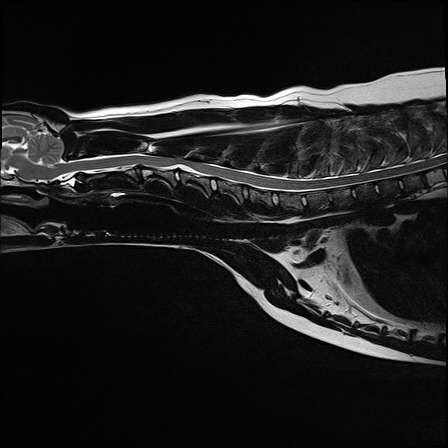Spinal Disorders
This section of the website is dedicated to understanding spinal disorders in dogs and cats. Spinal conditions can significantly impact mobility and quality of life, and early diagnosis and appropriate treatment are critical. Each webpage provides in-depth information on specific disorders, offering insights into their causes, clinical signs, diagnostic approaches, treatment options, and ongoing research. Explore the links and resources to enhance your understanding and support affected pets. The spinal condition syringomyelia has it own dedicated webpages.
Degenerative Myelopathy (DM)
Degenerative Myelopathy (DM) is a progressive, inherited disease of the spinal cord that predominantly affects older dogs. It is commonly seen in breeds such as German Shepherds, Boxers, and Pembroke Welsh Corgis. The condition starts with hind limb weakness and ataxia and eventually progresses to paralysis.
These webpages cover:
- The clinical signs and progression of degenerative myelopathy
- The role of genetic testing for the SOD1 mutation.
- Diagnostic techniques, including imaging and cerebrospinal fluid analysis, to rule out other conditions.
- Strategies for management and supportive care, including physical therapy, mobility aids, and palliative approaches.
- Updates on the latest research and advancements in degenerative myelopathy treatment.
Links
Wobbler Syndrome (Cervical Spondylomyelopathy)
Wobbler Syndrome (Cervical Spondylomyelopathy)
Wobbler Syndrome, also known as Cervical Spondylomyelopathy, is a condition affecting the cervical spine (neck), leading to spinal cord compression. This disorder is most common in large breeds like Dobermanns and Great Danes. Clinical signs include a characteristic wobbly gait, neck pain, and mobility difficulties.
On these webpages, you will find:
- An overview of the causes and types of Wobbler Syndrome.
- Details on diagnostic methods, including neurological exams and imaging techniques such as MRI or CT scans.
- Treatment approaches, from conservative options to surgical decompression and stabilisation for severe cases.
Links
Spinal Cord Disease in Pugs and Screw-Tail Breeds
Spinal Cord Disease in Pugs and Screw-Tail Breeds
Pugs and screw-tail breeds, including French Bulldogs, are predisposed to unique spinal issues due to their anatomy. Conditions such as Pug Myelopathy and hemivertebrae are commonly observed in these breeds, leading to progressive weakness, and mobility challenges.
These webpages explore:
- The specific challenges faced by brachycephalic breeds.
- Upcoming resources and FAQs dedicated to Pug Myelopathy and hemivertebrae.
Links
Spinal Trauma
Spinal trauma in dogs and cats can result from accidents, falls, or other traumatic events, leading to serious damage to the spinal cord. Early intervention is critical to improve outcomes.
This page will provide insights into:
- The types and causes of spinal trauma.
- Diagnostic approaches, including imaging and neurological assessments.
- Initial stabilization, treatment, and long-term management.
Links
Atlantoaxial Malformations
Atlantoaxial malformations are congenital or acquired abnormalities affecting the first two cervical vertebrae (C1 and C2) and their supporting ligaments. These malformations result in instability of the atlantoaxial joint, leading to spinal cord compression. The condition is most commonly seen in small and toy breeds such as Japanese Chins, Yorkshire Terriers, Chihuahuas, and Pomeranians.
These webpages provide detailed information on:
- Causes: Congenital malformations, trauma, or ligamentous laxity.
- Clinical Signs: Neck pain, reluctance to move the head or neck, ataxia, paresis, and in severe cases, tetraplegia or respiratory difficulties.
- Diagnosis: A combination of clinical signs, neurological examinations, and advanced imaging such as X-rays, CT scans, or MRI to identify vertebral abnormalities and spinal cord compression.
- Management:
- Conservative Treatment: Includes neck braces, strict cage rest, and anti-inflammatory medications for mild cases or for patients where surgery is not an option.
- Surgical Treatment: Stabilisation of the atlantoaxial joint is the preferred treatment for severe cases, involving techniques such as transarticular screws or pins to secure the vertebrae.
Links
